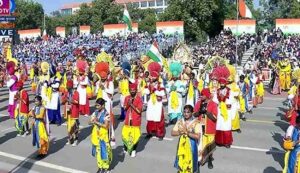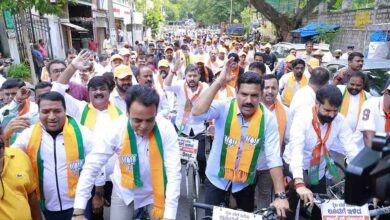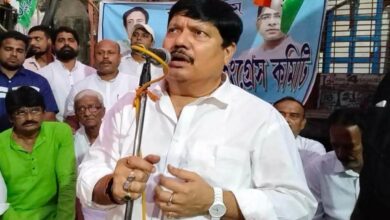Spectacular performances by Ministry of Culture and Sangeet Natak Akademi mesmerized audiences at Republic Day Parade 2025
New Delhi: At the Republic Day Parade 2025, the Ministry of Culture and Sangeet Natak Akademi’s spectacular performance, “Jayati Jai Mamah Bharatam” (JJMB), enthralled onlookers and created a cultural spectacle that honored the rich and vibrant heritage of Bharat’s folk and tribal traditions.

According to a press statement from the Ministry of Culture, this amazing group included more than 5000 folk and tribal performers from all across India, reflecting cultural legacy, young strength, and Nari Shakti, which symbolizes the diverse fabric of Indian culture.
India’s rich history was shown on a worldwide scale by more than 5,000 performers performing more than 50 folk and tribal dance genres. The choreography honored the themes of Ek Bharat Shreshtha Bharat, Virasat bhi Vikas bhi, and Viksit Bharat.
Its grandeur enthralled millions, and it was named ‘The Largest Indian Folk Variety Dance’ by Guinness World Records, a landmark that highlighted the importance of India’s cultural riches on a worldwide scale.
More than fifty folk and tribal dance styles were included in the show, which skillfully combined local identities into a single display of patriotism. From an emphasis on agricultural techniques and harvest rites, which were inspired by the natural and animal world, to the celebration of auspicious events, new beginnings, and the triumph of good over evil, the dance styles honored local traditions and customs.
While the vibrant Bihu from Assam and the vivacious Kalbelia from Rajasthan demonstrated the vitality of India’s folk traditions, Arunachal Pradesh artists brought their Snow Lion and Monpa Mask Dances’ enigma to life. The captivating Padayani from Kerala and the magnificent Chhau from Bengal and Odisha, which perfectly captured the narrative genius of Indian dance styles, enthralled the audience.
The Mentok Flower Dance, a Badhai traditional dance from Madhya Pradesh’s Bundelkhand area, signified fresh beginnings and auspicious events. Every performance used real motions, music, and costumes to create a really realistic and enthralling experience that mirrored the cultural uniqueness of the area.
“The symbolic portrayal of India’s oneness amid diversity was as magnificent as the performance itself. India’s cultural landscape is interwoven, as seen by the smooth mixing of regional dance styles and musical traditions. Every performance, from the lively Bhangra motions to the elegant Garba steps, from the elaborate Yakshagana storytelling to the rhythmic dynamism of Sambalpuri, honored the distinctive traditions of each place of origin while adding to the overall celebration of India’s cultural heritage.
“The event’s spiritual and celebratory undertones were further emphasized by the dynamic use of floral elements and ceremonial props, such as Ambala kavadi and pooja kavadi, which united traditional art forms with symbolic gestures of devotion and joy,” the announcement said.
The careful attention to detail in the costumes and props was essential to “Jayati Jai Mamah Bharatam”‘s success. Artists decked themselves up in traditional clothing with regionally distinctive designs, elaborate stitching, and vivid colors. Props like spears, swords, kavadi, and flower arrangements gave the dancing depth and authenticity, while genuine jewelry, elaborate headdresses, and accessories enhanced the performance’s visual complexity.
Under the direction of Director Chittaranjan Tripathy, the National School of Drama’s team of professionals, which included Aruna Kumar Malik, Parag Sharma, and Nalini Joshi, was instrumental in creating more than 60 original props, such as masks, animal frames, muppets, and ceremonial objects, which enhanced the performance’s visual range.
These components were especially made to go well with the dance, resulting in a cohesive visual story that honored both distinct regional identities and a sense of patriotism. The audience clapped and engaged with the animal props and muppets on their own.
The theme for this historic performance was derived from the musical composition “Jayati Jai Mamah Bharatam,” which was penned by Subhas Sehgal, composed by Shankar Mahadevan, and included voice-over by Harish Bhimani. The music pulsated along the whole Kartavya Path as a beacon of hope and optimism, skillfully bridging India’s ancient sounds with modern harmonies to create a soundtrack that spoke to audiences of all ages.
Co-choreographers Subhash Nakashe, Ankur Pathan, Kalpesh Dalal, Sanjay Sharma, and Ranjit Gogoi assisted Chairman Sangeet Natak Akademi and Sandhya Purecha in creating and curating this creative production.
“A group of 300 performers played a variety of native martial instruments to welcome the Republic Day 2025 Parade, which spoke to the pulse, melody, and aspirations of a billion Indians. Using instruments like dhols, bansuris, shehnais, and mridangams, the moving performance of “Saare Jahan Se Accha” expertly combined traditional and modern sounds.
A strong feeling of solidarity and pride was evoked in the crowd by the melodic interplay of these instruments. An auspicious and royal beginning to the event was provided by the heralding instruments, such as the shankh, tutari, and ranashingha, which produced a beat that electrified the march from the very first note,” the announcement said.
The Guinness World Record for “The Largest Indian Folk Variety Dance” was established by Jayati Jai Mamah Bharatam, adding to the spectacle and joyous atmosphere. During a special event this afternoon in Pusa, New Delhi, Guinness officials announced this historic accomplishment.
On behalf of all the artists, the certificate was accepted by Minister of Culture and Tourism Gajendra Singh Shekhawat, Secretary of the Ministry of Culture Arunish Chawla, and other Ministry of Culture officials.





